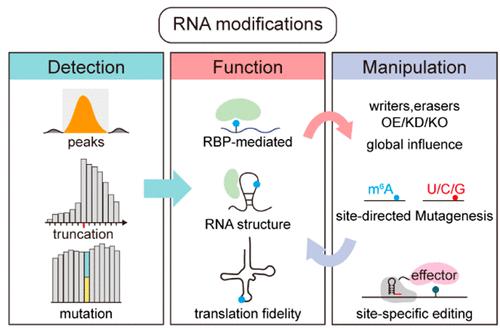当前位置:
X-MOL 学术
›
Acc. Chem. Res.
›
论文详情
Our official English website, www.x-mol.net, welcomes your
feedback! (Note: you will need to create a separate account there.)
Detection, Clinical Application, and Manipulation of RNA Modifications
Accounts of Chemical Research ( IF 16.4 ) Pub Date : 2023-09-28 , DOI: 10.1021/acs.accounts.3c00395 Jing Mo 1 , Xiaocheng Weng 1 , Xiang Zhou 1
Accounts of Chemical Research ( IF 16.4 ) Pub Date : 2023-09-28 , DOI: 10.1021/acs.accounts.3c00395 Jing Mo 1 , Xiaocheng Weng 1 , Xiang Zhou 1
Affiliation

|
With increasing research interest, more than 170 types of chemical modifications of RNA have been characterized. The epigenetic modifications of RNA do not alter the primary sequence of RNA but modulate the gene activity. Increasing numbers of regulatory functions of these RNA modifications, particularly in controlling mRNA fate and gene expression, are being discovered. To gain a deeper understanding of the biological significance and clinical prospects of RNA modifications, the development of innovative labeling and detection methodologies is of great importance. Owing to the dynamic features of RNA modifications and the fact that only a portion of genes are modified, detection methods should accurately reveal the precise distribution and modification level of RNA modifications. In general, detection methodologies identify specific RNA modifications in two ways: (1) enriching modification-containing RNAs; and (2) altering the Watson-Crick base pairing pattern to produce truncation or mutation signatures. Additionally, it is important to develop flexible and accurate manipulation tools that enable the installation or removal of RNA modifications at specific positions to investigate the biological functions of a single site. With the development of detection and manipulation methods, the scientific understanding of the biological functions of RNA modifications has increased, paving the way for applications of RNA modifications in disease diagnosis and treatments.
中文翻译:

RNA 修饰的检测、临床应用和操作
随着研究兴趣的增加,超过 170 种类型的 RNA 化学修饰已被表征。RNA 的表观遗传修饰不会改变 RNA 的一级序列,但会调节基因活性。人们正在发现越来越多的这些 RNA 修饰的调节功能,特别是在控制 mRNA 命运和基因表达方面。为了更深入地了解RNA修饰的生物学意义和临床前景,开发创新的标记和检测方法非常重要。由于RNA修饰的动态特征以及仅部分基因被修饰的事实,检测方法应准确揭示RNA修饰的精确分布和修饰水平。一般来说,检测方法通过两种方式识别特定的RNA修饰:(1)富集含有修饰的RNA;(2) 改变 Watson-Crick 碱基配对模式以产生截短或突变特征。此外,开发灵活而准确的操作工具非常重要,这些工具能够在特定位置安装或去除RNA修饰,以研究单个位点的生物学功能。随着检测和操作方法的发展,人们对RNA修饰的生物学功能的科学认识不断加深,为RNA修饰在疾病诊断和治疗中的应用铺平了道路。
更新日期:2023-09-28
中文翻译:

RNA 修饰的检测、临床应用和操作
随着研究兴趣的增加,超过 170 种类型的 RNA 化学修饰已被表征。RNA 的表观遗传修饰不会改变 RNA 的一级序列,但会调节基因活性。人们正在发现越来越多的这些 RNA 修饰的调节功能,特别是在控制 mRNA 命运和基因表达方面。为了更深入地了解RNA修饰的生物学意义和临床前景,开发创新的标记和检测方法非常重要。由于RNA修饰的动态特征以及仅部分基因被修饰的事实,检测方法应准确揭示RNA修饰的精确分布和修饰水平。一般来说,检测方法通过两种方式识别特定的RNA修饰:(1)富集含有修饰的RNA;(2) 改变 Watson-Crick 碱基配对模式以产生截短或突变特征。此外,开发灵活而准确的操作工具非常重要,这些工具能够在特定位置安装或去除RNA修饰,以研究单个位点的生物学功能。随着检测和操作方法的发展,人们对RNA修饰的生物学功能的科学认识不断加深,为RNA修饰在疾病诊断和治疗中的应用铺平了道路。

















































 京公网安备 11010802027423号
京公网安备 11010802027423号